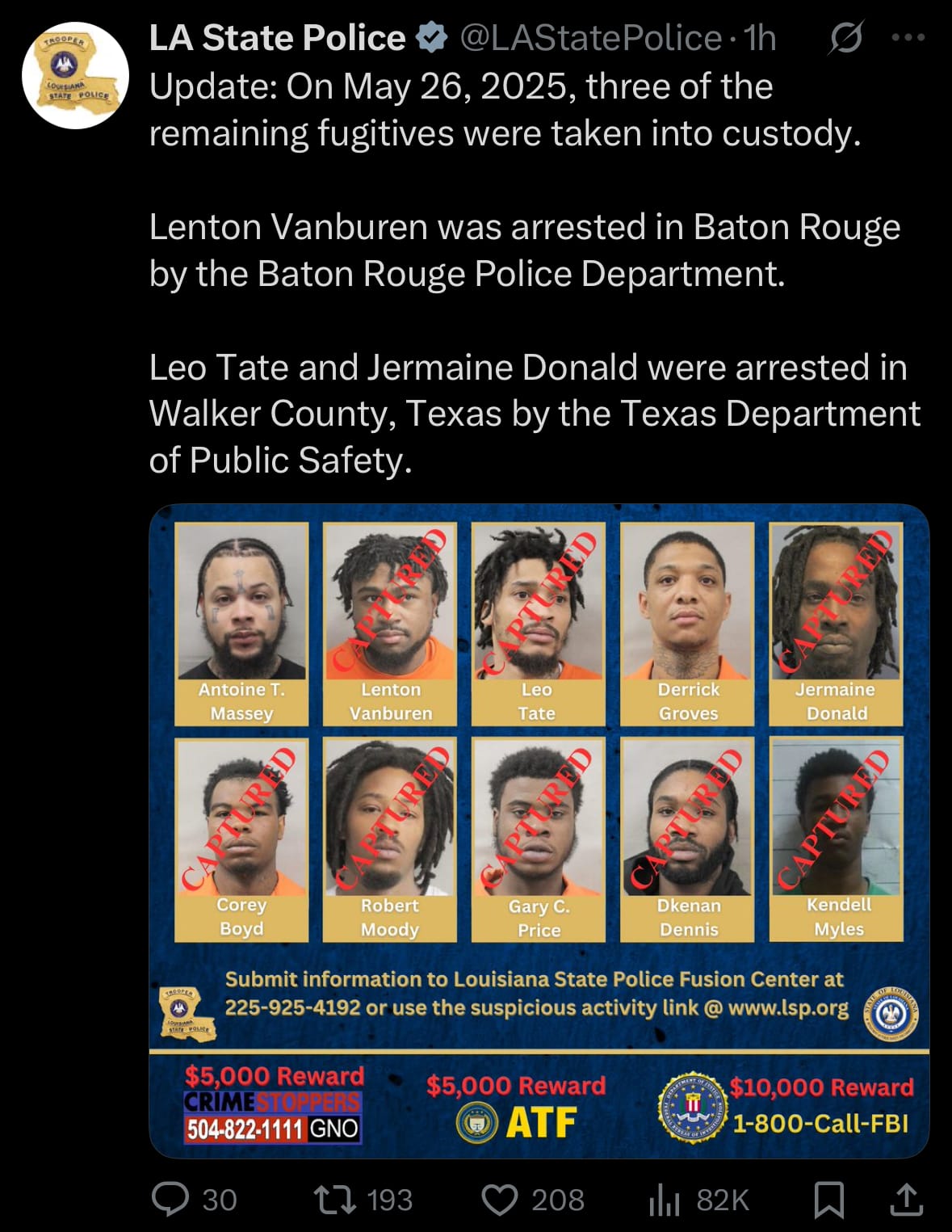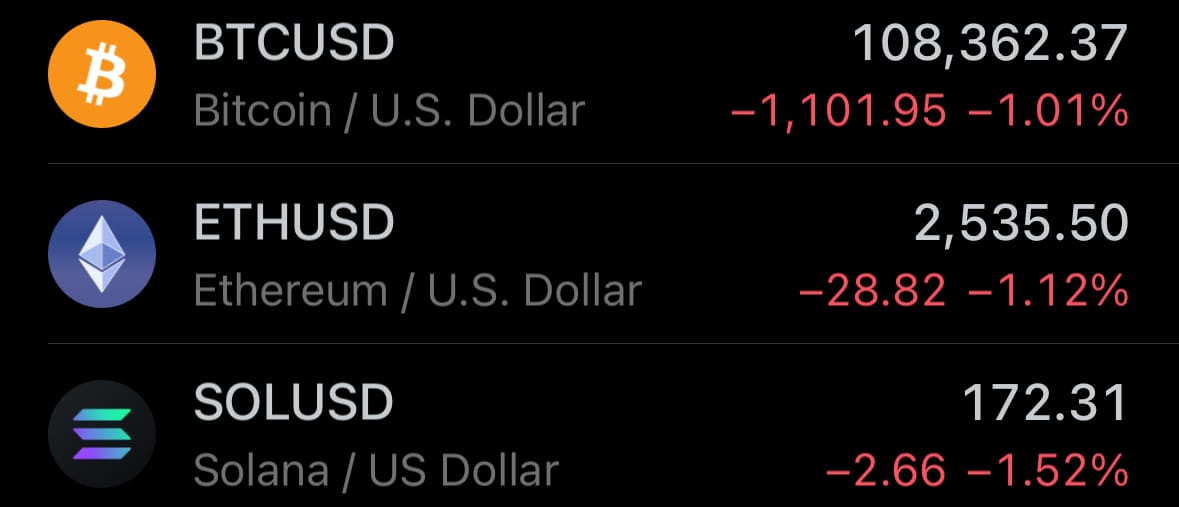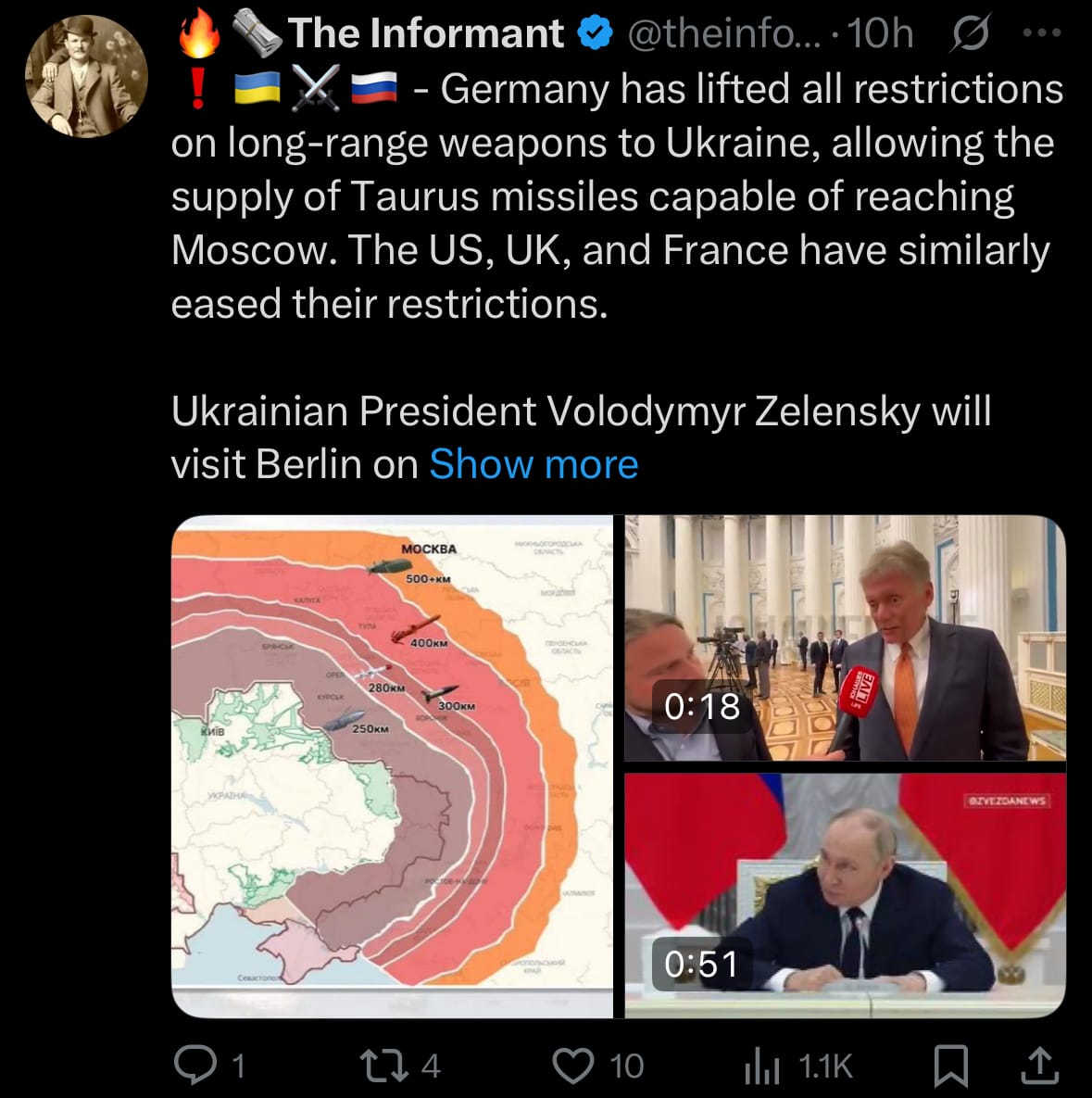Tuesday☕️

Trending:
- Yesterday, May 26, 2025, the Louisiana State Police reported the arrests of three fugitives—Lenton Vanburen in Baton Rouge by the Baton Rouge Police Department, and Leo Tate and Jermaine Donald in Walker County, Texas, by the Texas Department of Public Safety—bringing the total number of captured individuals to nine out of 11 who escaped from the Orleans Justice Center in New Orleans. The escape occurred on May 16, 2025, at around 1 a.m., when the inmates exploited security weaknesses by breaking through a hole in the wall behind a toilet in a cell, navigating through a plumbing chase, and exiting via a fire escape. They then scaled a wall, crossed Interstate 10, and dispersed, triggering a multi-agency manhunt. Rewards ranging from $5,000 to $10,000 were offered by Crime Stoppers, the ATF, and the FBI for information leading to their capture, with only Derrick Groves and Antoine Massey still at large as of this update.

- The escapees were being held on serious charges, primarily involving violent crimes. Derrick Groves was convicted of second-degree murder, Corey Boyd and Jermaine Donald faced charges of second-degree murder, aggravated assault, and false imprisonment, and Leo Tate was convicted of obstruction while also facing murder charges, according to posts on X. The escape exposed longstanding security issues at the Orleans Justice Center, with reports indicating that defective locks, inadequate staffing, and structural vulnerabilities contributed to the breakout—one of the largest in Louisiana’s history. The incident has heightened public safety concerns, with families of victims, such as one linked to Derrick Groves, reportedly going into hiding. This case underscores the challenges of maintaining security in aging jail facilities and the complexities of coordinating cross-state law enforcement efforts to apprehend dangerous fugitives.
Economics & Markets:
- Yesterday’s commodity market:

- Yesterday’s crypto market:

Geopolitics & Military Activity:
- Yesterday, May 26, 2025, reports have indicated that Germany has lifted restrictions on supplying long-range weapons to Ukraine, potentially allowing the transfer of Taurus missiles with a 500-kilometer range, capable of reaching Moscow from Ukrainian territory (unconfirmed). Ukrainian President Volodymyr Zelenskyy is scheduled to visit Berlin, likely to discuss further coordination and support amid these reported policy shifts.

- The Taurus missiles, developed by Germany and Sweden, are precision-guided weapons designed for striking high-value military targets at significant distances. A Kremlin statement on May 26, 2025, cautioned that such actions by European nations could be dangerous, potentially leading to heightened Russian responses, such as retaliatory strikes or increased military activity. While these reports reflect a possible Western effort to strengthen Ukraine’s defense against Russian forces, particularly in eastern Ukraine, the lack of official confirmation leaves uncertainty around the decision’s details and timing.
Environment & Weather:
- Yesterday, May 26, 2025, forest fires have spread across 10 kilometers in Sarar Bani Malik, a region south of Taif, Saudi Arabia. Taif, situated in the Mecca Province at an elevation of about 1,879 meters above sea level, is known for its relatively temperate climate and scenic mountainous terrain, which supports forests and agricultural areas.

- Historically, wildfires in Saudi Arabia are relatively rare compared to other regions like the Mediterranean or Australia, due to the country’s predominantly desert landscape. However, in mountainous areas like Taif, where vegetation is denser, fires can occur, especially during dry seasons. Data on wildfire frequency in Saudi Arabia is limited, but regional studies suggest an uptick in such events across the Middle East in recent years, driven by climate change factors like rising temperatures and prolonged droughts, which exacerbate fire risks and challenge disaster management efforts.
Science & Technology:
- Nvidia is developing a modified version of its Blackwell AI chip specifically designed for the Chinese market, according to reports. This release is a response to U.S. export controls that restrict the sale of advanced AI chips to China due to national security concerns. The new chip, a lower-cost variant of Nvidia’s high-performance Blackwell architecture, is tailored to comply with these regulations while supporting AI workloads. This move enables Nvidia to maintain its market presence in China, where demand for AI hardware remains strong amid growing competition from domestic companies like Huawei.
- The adapted Blackwell chip is intended for applications such as cloud computing and data centers, though it features reduced performance to align with export restrictions. This follows Nvidia’s prior efforts, such as the H20 chip, to provide compliant solutions for the Chinese market. While specific technical details and pricing have not been disclosed, the launch highlights Nvidia’s efforts to navigate regulatory challenges while addressing market needs in a complex geopolitical landscape.
Statistic:
- Largest assets on Earth by market capitalization:
- Gold: $22.408T
- 🇺🇸 Microsoft: $3.345T
- 🇺🇸 NVIDIA: $3.201T
- 🇺🇸 Apple: $2.916T
- Bitcoin: $2.153T
- 🇺🇸 Amazon: $2.133T
- 🇺🇸 Alphabet (Google): $2.050T
- Silver: $1.885T
- 🇸🇦 Saudi Aramco: $1.625T
- 🇺🇸 Meta Platforms: $1.576T
- 🇺🇸 Tesla: $1.093T
- 🇺🇸 Berkshire Hathaway: $1.085T
- 🇺🇸 Broadcom: $1.075T
- 🇹🇼 TSMC: $995.70B
- 🇺🇸 Walmart: $770.80B
- 🇺🇸 JPMorgan Chase: $724.53B
- 🇺🇸 Visa: $677.26B
- 🇺🇸 Eli Lilly: $640.72B
- 🇨🇳 Tencent: $602.33B
- SPDR S&P 500 ETF Trust: $531.49B
- 🇺🇸 Mastercard: $511.77B
- 🇺🇸 Netflix: $504.46B
- 🇺🇸 Costco: $447.45B
- 🇺🇸 Exxon Mobil: $444.02B
- 🇺🇸 Oracle: $437.37B
History:
- The history of orbital weapons spans Cold War ambitions to modern strategic initiatives, driven by superpower rivalries. Early concepts like the U.S. Project BAMBI in the 1960s proposed satellites with nets to intercept ballistic missiles but were scrapped due to technical and cost issues. In the 1980s, Reagan’s Strategic Defense Initiative (SDI), or “Star Wars,” pushed for space-based lasers, particle beams, and kinetic interceptors like “Brilliant Pebbles,” small satellites designed to ram missiles. Another U.S. concept, “Rods from God,” envisioned satellites dropping tungsten rods from orbit to strike targets with kinetic force rivaling small nuclear warheads. Rumored to be a highly secretive program, its deployment status remains unclear, with no public confirmation of operational use, though speculation persists due to classified military research. The Soviet Union explored similar ideas, like the Polyus-Skif orbital laser, rumored to have failed during a 1987 launch. Both nations faced criticism for risking space militarization, with the 1967 Outer Space Treaty—banning nuclear weapons in space and limiting military activities—constraining progress. By the 1990s, focus shifted to ground- and sea-based defenses due to treaty restrictions and technological hurdles.
- Today, the U.S. is developing the “Golden Dome” missile defense system, announced in 2025, aiming to counter ballistic, cruise, and hypersonic missiles with space-based sensors and interceptors. Multiple defense contractors, including companies like SpaceX and Lockheed Martin, have been assigned to the project, which envisions thousands of orbiting interceptors and sensors by the mid-2030s. Estimated to cost $175–500 billion, the program faces skepticism over its feasibility, particularly for hypersonic interception, and has drawn objections from Russia and China, who warn of a new arms race. Both nations have tested anti-satellite (ASAT) weapons—China’s 2007 test and Russia’s 2021 test created hazardous debris fields, raising global concerns about orbital safety. Rumors persist of their own secretive orbital weapons, including lasers and co-orbital satellites, though no deployments are verified. Challenges like space debris, treaty violations, and escalation risks remain critical, with critics warning that orbital weapons could destabilize space, threatening global satellite networks. The Golden Dome reflects the U.S.’s renewed push for space-based defense amid these tensions.
Image of the day:

Thanks for reading!
Earth is complicated, we make it simple.
Click image to view the Earth Intelligence System:



Support/Suggestions Email:
earthintelligence@earthintel.news




